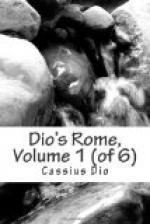Suidas.—A lexicographer of the tenth century, composer of the most comprehensive Greek dictionary of early times. It is a manual at once of language and of antiquities. Inestimable as its value is, the workmanship is careless and uneven. The arrangement is alphabetical.
John Tzetzes.—A Greek grammarian of the twelfth century. His learning was great but scarcely equaled his self-conceit, as repeatedly displayed in passages of his works. Many of his writings are still extant. One of these is called Chiliades (or Thousands), a name bestowed by its first editor, who divided the work into sections of one thousand lines each. The subject-matter consists of the most miscellaneous historical or mythological narratives or anecdotes, absolutely without connection. Tzetzes copied these accounts from upward of four hundred writers,—one of them being Cassius Dio. The Chiliades is written in the so-called Versus politicus, or “political verse,” which is really not verse at all, but a kind of decadent doggerel.—A minor treatise by the same author is the Exegesis of the Iliad of Homer, published by Hermann (Leipzig, 1812).
Isaac Tzetzes, who has attracted less attention than his brother John, is best known as the author of a commentary on the Cassandra of Lycophron (a poem of 1474 iambic verses by a post-classical tragedian, about 285 B.C., embodying the warnings of the royal prophetess and couched in appropriately incomprehensible expressions). It was hardly worth all the care that Tzetzes lavished upon it. From manuscript evidence and various claims of John Tzetzes it seems that John worked over, improved, and enlarged the commentary of his brother. Isaac’s name, however, still remains associated with this particular exposition.
We are now at length placed in a position to consider the condition of the ultimate portion of the work, i.e., the last twenty books, Sixty-one to Eighty inclusive. In general it may be said that for this section of the history we are thrown back upon an epitome of Ioannes Xiphilinus, who lived about fifty years earlier than the Ioannes Zonaras recently under discussion. To this general statement there are two important exceptions. First, even as early as Xiphilinus wrote (eleventh century) nearly two books of this last portion had perished. Book Seventy, containing the reign of Antoninus Pius, was entirely gone save a few miserable chapters, and Book Seventy-one had suffered the same fate in its beginning, so that our account of the renowned Marcus Aurelius begins practically with the year 172 instead of 161. The gap thus created has been partially filled by extracts of every conceivable quality and merit, from Suidas, from John of Antioch, even from Asinius Quadratus. This on the side of loss: on the side of gain there are numerous little excerpts (just as in the case of the early books) that may serve to fill crevices or cover scars, and above all there exists a parchment manuscript, known as Vaticanus 1288, older than Mediceus A, older than Venetus A, and containing Books Seventy-eight and Seventy-nine probably very much as Dio wrote them, save that the account is mutilated at beginning and end.




